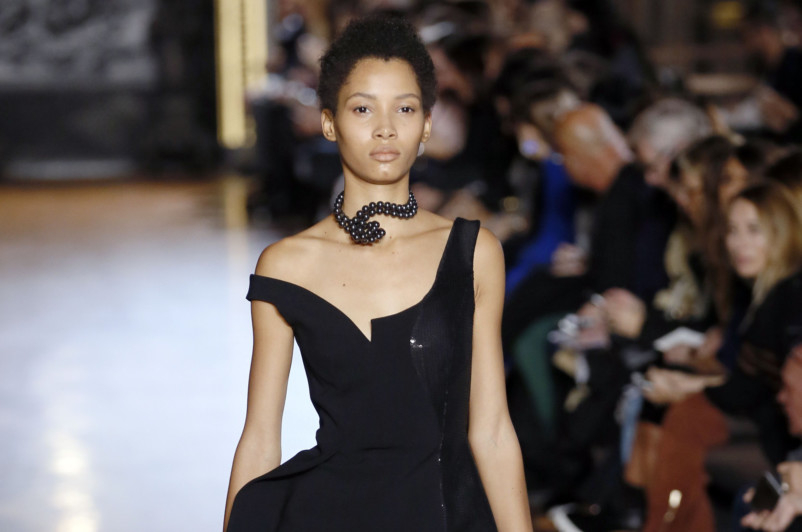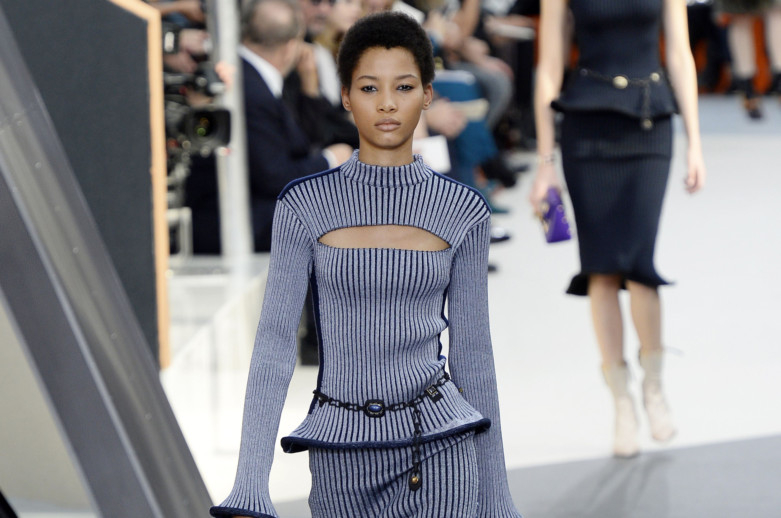
For 15 years — or 30 runway seasons in fashion speak — Prada had no black models on its catwalks. After the 1990s, a decade of fashion in which the clothes were being overshadowed by the larger-than-life supermodels wearing them, Miuccia Prada took control of matters by hiring a seemingly endless stream of white, eastern European models.
Then came Jourdan Dunn in 2008, followed by a growing list of black, Asian and Hispanic models including Malaika Firth, Prada’s first black campaign star in 19 years. It’s a known fact within the fashion world that where Prada goes, the rest of the industry follows. And so the very same brand that ushered in an era that shut out non-white models helped bring models of colour back in. But this season, Prada introduced a surprising new dimension to the subject of diversity in fashion: a tiny little afro.
In theory, wearing one’s hair in its natural state should be a non-event. Black women have been doing it since the dawn of time. But throughout history, black hair has been alternately celebrated, reviled and politicised to the point of exhaustion — becoming the stuff of women’s magazine articles, music, literature, art and even headline news, as proven by the recent Oscar night controversy, in which Giuliana Rancic quipped that a dreadlocked Zendaya Coleman looked like she should smell of “patchouli oil or weed.”
Black hair is so rarely seen on the catwalk without having been blown straight or pressed flat — let alone in a show as influential as Prada’s — that the sight of it not only set off a wave of enthusiasm on social media, it also launched the career of Lineisy Montero, who became the season’s most talked about new model. “I truly didn’t understand how important that show was,” said Montero, over email through a translator. The a 19-year-old speaks Spanish, and relied on an interpreter to help her navigate Milan and Paris.
A native of Santo Domingo in the Dominican Republic, she only began modelling three months ago when an agent for Next Model Management signed Montero after seeing her in a competition. Prada was her first ever runway show. That’s the fashion equivalent of an actor winning an Oscar for her first feature film (hello, Lupita Nyong’o ).
“I had not walked for any designer, ever,” Montero added. Whatever the thinking from Prada (the show’s casting director, Ashley Brokaw, could not be reached for comment), one can’t deny the power in the image of a single afro among 41 slick ponytails and the message it conveys to women who have faced enduring, yet completely erroneous notions that the kind of hair that swings and blows in the wind is most beautiful.
Being current
Style.com — the fashion industry’s most influential website — featured Montero as its home page cover photo the next day. “I think Lineisy represents something completely new to what is in the beauty conversation in fashion at the current moment,” said Kyle Hagler, the president of Montero’s agency Next Models, who famously guided the careers of Liya Kebede and Joan Smalls during his days as a manager at IMG Models.
He added: “I do feel that Lineisy’s appearance with natural hair on the Prada runway is important. It speaks to the range in beauty and the importance of embracing one’s own natural beauty.” The editors in the room certainly took notice. “There’s always a mass synchronised lifting of iPhones when a well-known girl like Karlie Kloss or Gigi Hadid walks out at any show. And I definitely saw a lot of editors snapping pics of Lineisy, which is what made me notice her in the first place,” said Nicole Vecchiarelli, editor of DuJour, a New York-based luxury magazine.
Meanwhile, on social media, commencers were celebrating Prada’s gradual inclusion of a more well-rounded picture of black beauty. “Brilliant, beautiful and positive for everyone looking to see a bit of themselves in the industry,” the photographer Robin Westfield posted on Instagram.
Montero is hardly the first model to shun the flat iron, pressing comb and weave. Bethann Hardison did so in the 70s, paving the way for models such as Roshumba Williams in the 1980s, Alek Wek in the 1990s and Rose Cordero a decade later. “It was hard back in my day, because when I walked out onto that runway with my little afro, it got a reaction. And not the best kind,” Hardison said. But if the autumn/winter 2015 season is an indication, we could be seeing a lot more models with their natural hair texture on show.
Making waves
Montero has since followed her debut with Paris appearances in Loewe and Balenciaga, where she walked with models including Ajak Deng, another beauty who is known for her short afro. On Sunday, Montero had an even bigger runway coup by walking in Celine, which also featured another stunning newcomer with a natural ‘fro, Karly Loyce. On Wednesday — the final day of Paris fashion week — it was Miu Miu and Louis Vuitton.
The black natural hair movement has been around since the 1960s, but has notably picked up steam in the past five years as sales of chemical straighteners dropped and an increasing number of celebrities such as singer Solange Knowles, actor Nyong’o (a campaign star for Prada sister brand Miu Miu who wore Prada to pick up her Oscar), and longtime natural hair advocate Tracee Ellis Ross wave the banner for curly haired girls. But it’s also likely that casting directors and designers could merely be embracing the afro as a way to accessorise the ubiquitous 70s trend.
“It’s a sign of the times,” said the popular fashion blogger Tamu McPherson, of All the Pretty Birds. McPherson stopped straightening her own hair two years ago. She said, “The Prada collection was inspired by the late 1960s and early 1970s. [And Montero’s] look was reminiscent of chic black women who wore their hair natural at that time. It’s relevant today, as many black women are returning to wearing their hair natural and rejecting the idea that straight hair is more beautiful.”
Still, one can always hope that the afro will transcend the trends and remain long after the season’s flared leg trousers have rotated out of style. Hagler is optimistic: “Natural hair will hopefully resonate forever.” Montero, for one, doesn’t plan to change her hair any time soon. “I love it,” she said. “I feel very comfortable.”















